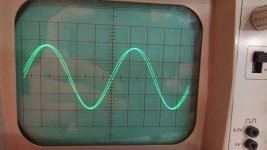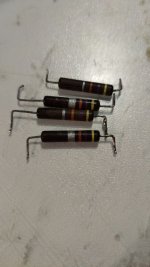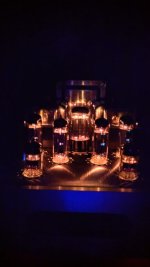I saw the ‘275VAC’ label on my Baby Huey EL84 boards, and since I had a Toroidy TSTA0250/001 with a secondary with a 275VAC tap, I thought no more of it, until powering up for the first time today. Unfortunately the B+ is just too high with that one - around 380VDC.
OldHector, you are right. The ‘275VAC’ on the PCB really should NOT be there. The Toroidy TSTA025/001 is ideal for the EL34 Baby Huey, but for the EL84 you need around 230VAC with the built-in power supply. What to do? Burning up that many volts in a honking resistor seems wasteful to me.
I suggest you save your Toroidy TSTA025/001 for use with the EL34 BHs and get a new transformer with ~230VAC secondary. But you could use your Toroidy and convert it to a psuedo choke input supply. Put a smallish film at cap C7 (instead of the 47uF Electrolytic cap) as input cap after the rectifiers followed by a choke with inductance sufficient followed by the rest of the PCB power supply circuit. You will have to simulate (or tweek) the value of C7 to get the B+ around 300-320DC for your BHEL84s boards.
Best wishes with your build.
Last edited:
Francois G,
Could you have a look at the thread "Tube amp identification" which I started recently. In post 7 I have the specs listed for the various transformers and choke I have to play with. Easy read as only 3 pages.
Mostly as a start to see if any of the iron is suitable for an EL84, I am wondering if I can use the 20 watt Hammond 1626 Xfmr's with 6.6kohm primary impedance, 80ma DC per side, 4 / 16 sec.impedance. I know that most use an 8k ohm primary impedance.
Also not sure if the Hammond 710 plate transformer and 159ZC choke could be used.
Thanks for the help,
Myles
Could you have a look at the thread "Tube amp identification" which I started recently. In post 7 I have the specs listed for the various transformers and choke I have to play with. Easy read as only 3 pages.
Mostly as a start to see if any of the iron is suitable for an EL84, I am wondering if I can use the 20 watt Hammond 1626 Xfmr's with 6.6kohm primary impedance, 80ma DC per side, 4 / 16 sec.impedance. I know that most use an 8k ohm primary impedance.
Also not sure if the Hammond 710 plate transformer and 159ZC choke could be used.
Thanks for the help,
Myles
Hi Miles,
Let me make sure I understand the context. You would like to use transformers from an old amp you found, rather than buying transformers that fit the EL84BH circuit more ideally, right? I will try to provide some feedback.
Outputs: It appears your Hammond 1626X output transformers feature 4 and 16 Ohm outputs only - will one of those suit your loudspeaker load? If yes, I believe you could find an acceptable operating point to suit the 6.6k primary impedance, and 40% UL taps, likely with a B+ =<300V. Check the Mullard EL84 data sheet for a UL operating point as follows:
B+ = 300Vdc
Ra-a = 6k
Ik = 28 Ma per tube no signal
Vin = 17 V rms
Pout = 14.4 W at 0.85% distortion.
Power transf: I looked at your other thread but had difficulty matching up the characteristic with the corresponding values you listed. If it is a standard 710 Hammond the secondary is 350-0-350Vac at 147 ma, with no heater or bias coils (you will have to buy additional transformers for these). You may be able to design a choke input supply with your transformer, possibly using tube rectifiers to lower the voltage out, but even so the 147 ma is less than ideal.
The 159ZC choke has too low inductance to work as choke input (you need to exceed the critical inductance, probably about 4H) but will work in a CLC supply if you have a secondary of around 220-0-220Vac on your power transformer.
The “proper” magnetics will deliver better results, but what you have might work satisfactorily, if not optimally, provided you are driving 4 or 16 Ohm speakers. I suggest you play around with Duncan’s PSUD2 simulator to see how these repurposed parts might work.
Hope this helps.
Let me make sure I understand the context. You would like to use transformers from an old amp you found, rather than buying transformers that fit the EL84BH circuit more ideally, right? I will try to provide some feedback.
Outputs: It appears your Hammond 1626X output transformers feature 4 and 16 Ohm outputs only - will one of those suit your loudspeaker load? If yes, I believe you could find an acceptable operating point to suit the 6.6k primary impedance, and 40% UL taps, likely with a B+ =<300V. Check the Mullard EL84 data sheet for a UL operating point as follows:
B+ = 300Vdc
Ra-a = 6k
Ik = 28 Ma per tube no signal
Vin = 17 V rms
Pout = 14.4 W at 0.85% distortion.
Power transf: I looked at your other thread but had difficulty matching up the characteristic with the corresponding values you listed. If it is a standard 710 Hammond the secondary is 350-0-350Vac at 147 ma, with no heater or bias coils (you will have to buy additional transformers for these). You may be able to design a choke input supply with your transformer, possibly using tube rectifiers to lower the voltage out, but even so the 147 ma is less than ideal.
The 159ZC choke has too low inductance to work as choke input (you need to exceed the critical inductance, probably about 4H) but will work in a CLC supply if you have a secondary of around 220-0-220Vac on your power transformer.
The “proper” magnetics will deliver better results, but what you have might work satisfactorily, if not optimally, provided you are driving 4 or 16 Ohm speakers. I suggest you play around with Duncan’s PSUD2 simulator to see how these repurposed parts might work.
Hope this helps.
Last edited:
Miles,
I wanted to mention that for a suitable, inexpensive (<$40) power Antek transformer has this one:
AS-2T230 - 200VA 230V Transformer - AnTek Products Corp
It has 2x230Vac coils at 400ma, and 2x6.3Vac at 4Amps (the website sheet is wrong).
In addition you will need a small 40-50 Vac bias transformer - Mouser sells these for ~$5 each.
I wanted to mention that for a suitable, inexpensive (<$40) power Antek transformer has this one:
AS-2T230 - 200VA 230V Transformer - AnTek Products Corp
It has 2x230Vac coils at 400ma, and 2x6.3Vac at 4Amps (the website sheet is wrong).
In addition you will need a small 40-50 Vac bias transformer - Mouser sells these for ~$5 each.
Francois,
Thanks for the info. I realize I may not have the ideal parts, just trying to see if any will work. All this old iron and the data was obtained from the 1974 Hanmmond catalogue. Attached is a clearer list, minus the choke data. Bottom line is any suitable for el84.?
Output Transformers
Cat. Audio Primary Max. DC mA Secondary
No. Watts Impedance Per Side Impedance
1626 20 6600 ct 80 4/16
FILAMENT AND RECTIFIER TRANSFORMER Multiple Secondary
Cat. Secondary Sec. rms.
No. Volts Amps Ins. Test
1136X 5.0 ct 3.0 2500
6.3 ct 5.0 2500
PLATE TRANSFORMER- Primary 115 Volts, 50/60 Hz
Cat. Secondary D.C. Volts D.C. mA
No. A.C. Volts Choke Input CCS ICAS
710 375-0-375 300 300 450
Thanks for the info. I realize I may not have the ideal parts, just trying to see if any will work. All this old iron and the data was obtained from the 1974 Hanmmond catalogue. Attached is a clearer list, minus the choke data. Bottom line is any suitable for el84.?
Output Transformers
Cat. Audio Primary Max. DC mA Secondary
No. Watts Impedance Per Side Impedance
1626 20 6600 ct 80 4/16
FILAMENT AND RECTIFIER TRANSFORMER Multiple Secondary
Cat. Secondary Sec. rms.
No. Volts Amps Ins. Test
1136X 5.0 ct 3.0 2500
6.3 ct 5.0 2500
PLATE TRANSFORMER- Primary 115 Volts, 50/60 Hz
Cat. Secondary D.C. Volts D.C. mA
No. A.C. Volts Choke Input CCS ICAS
710 375-0-375 300 300 450
Sorry Francois, copy/paste does not preserve formatting. Hope below helps.
Output Transformers
1626X, 20W, 6600 ct ohm P Impedance, DC per side 80ma,
FILAMENT AND RECTIFIER TRANSFORMER Multiple Secondary
1136X, 5.0V ct, 3 A, Sec. rms test 2500 or 6.3V ct, 5A, 2500 (both were listed)
PLATE TRANSFORMER- Primary 115 Volts, 50/60 Hz
710, 375-0-375 VAC , 300V DC choke input, DC CCS 300, mA ICAS 450
MM
Output Transformers
1626X, 20W, 6600 ct ohm P Impedance, DC per side 80ma,
FILAMENT AND RECTIFIER TRANSFORMER Multiple Secondary
1136X, 5.0V ct, 3 A, Sec. rms test 2500 or 6.3V ct, 5A, 2500 (both were listed)
PLATE TRANSFORMER- Primary 115 Volts, 50/60 Hz
710, 375-0-375 VAC , 300V DC choke input, DC CCS 300, mA ICAS 450
MM
Hi Kokanee,
When you factor in the man hours you will need to invest in a BH84, it does not make sense to be too compromised with the components you are using. Those transformers and chokes will find a use, but are not really candidates for this project.
Since you have a separate filament transformer, if you invest in a variac off an auction site, then you have the makings of a flexible power supply for developing tube circuits.
Those power transformers would suit an amp with bigger octal tubes, needing a higher B+. The absence of a 50v secondary tap for fixed bias points to a cathode biased solution.
When you factor in the man hours you will need to invest in a BH84, it does not make sense to be too compromised with the components you are using. Those transformers and chokes will find a use, but are not really candidates for this project.
Since you have a separate filament transformer, if you invest in a variac off an auction site, then you have the makings of a flexible power supply for developing tube circuits.
Those power transformers would suit an amp with bigger octal tubes, needing a higher B+. The absence of a 50v secondary tap for fixed bias points to a cathode biased solution.
Last edited:
Thanks for clarifying the iron that you have in hand. This output transformer would work nicely for BH84 at the operating point I listed above, and assuming it is designed and wound for high fidelity.Output Transformers
1626X, 20W, 6600 ct ohm P Impedance, DC per side 80ma,
This will work well for BH84, given that you will probably use a tube rectifier. (Note that Marc recommended DC for the BH heaters; that makes your 6.3Vac at 5A a bit close), but several builders found AC heating satisfactory). You will need that additional small bias transformer as well.FILAMENT AND RECTIFIER TRANSFORMER Multiple Secondary
1136X, 5.0V ct, 3 A, Sec. rms test 2500 or 6.3V ct, 5A, 2500 (both were listed)
With the right tube rectifier (likely 5U4) and “real choke input” filter you should get 300Vdc (as specified by Hammond) which is good for BH84. (I agree with oldHector your plate transformer will be perfect for a EL34 amp and overkill for BH84). You will need to buy a choke with sufficient inductance to exceed the critical inductance, probably at least 4H and ~250 Ma rating.PLATE TRANSFORMER- Primary 115 Volts, 50/60 Hz
710, 375-0-375 VAC , 300V DC choke input, DC CCS 300, mA ICAS 450
MM
In summary, I think you have the iron for an uncompromised BH84 build, if you add the small bias transformer and the right choke for a choke input filter. The quality of the output transformer is unknown (to me), but you could upgrade it in the future, if needed.
Last edited:
Hi Hector and Francois,
Thank you on your views of building the BH84. Hector, I have a Variac, so thanks for the tip. Below is the Hammond marketing info on the 1600 series OPT.
AUDIO OUTPUT I TRANSFORMERS HAMMOND I 1600 SERIES - 10 Watt to 75 Watt Designed for Hi-Fi, Stereo or P.A. system applications (Tube circuits)..
Sturdy, convenient, 4 hole above chassis "X Mtg." (See p. 5 details) in semi-gloss black enamel. Screen taps on 1 620 (21 % of pri. turns) and 1626 (41 % of pri. turns); for ultra-linear operation if required.
Type 620 - Frequency response 50 to 15 kHz (-1 dB ref 1 000 Hz minimum)
Type 1626 is from 30 to 30 kHz.
Eli Duttman in my other thread commented that Hammond is OK, but not top shelf like custom wound products.
Bottom line is I have some time to ponder this build, and see if others have built with a lower impedance OPT. Thank you gentlemen for your time, and I will see what happens on the other thread for idea's also.
Regards,
Myles
Thank you on your views of building the BH84. Hector, I have a Variac, so thanks for the tip. Below is the Hammond marketing info on the 1600 series OPT.
AUDIO OUTPUT I TRANSFORMERS HAMMOND I 1600 SERIES - 10 Watt to 75 Watt Designed for Hi-Fi, Stereo or P.A. system applications (Tube circuits)..
Sturdy, convenient, 4 hole above chassis "X Mtg." (See p. 5 details) in semi-gloss black enamel. Screen taps on 1 620 (21 % of pri. turns) and 1626 (41 % of pri. turns); for ultra-linear operation if required.
Type 620 - Frequency response 50 to 15 kHz (-1 dB ref 1 000 Hz minimum)
Type 1626 is from 30 to 30 kHz.
Eli Duttman in my other thread commented that Hammond is OK, but not top shelf like custom wound products.
Bottom line is I have some time to ponder this build, and see if others have built with a lower impedance OPT. Thank you gentlemen for your time, and I will see what happens on the other thread for idea's also.
Regards,
Myles
Looking at this document ( https://www.next-tube.com/articles/Veen2/Veen2EN.pdf ) I would like to ask if anyone ever tried case 5 with this circuit, considering shunt feedback instead of cathode feedback.
I've plotted a loadline for 320V B+ and 4.4 kOhm Raa with -23% distributed load (that is obtained connecting the screens to the 23% tap of the opposite side of the primary), and one pair of EL84 can go closer to 30 Wrms.
Of course the OPT must be of the highest possible quality, as I'm exarcebating its own characteristics.
I've plotted a loadline for 320V B+ and 4.4 kOhm Raa with -23% distributed load (that is obtained connecting the screens to the 23% tap of the opposite side of the primary), and one pair of EL84 can go closer to 30 Wrms.
Of course the OPT must be of the highest possible quality, as I'm exarcebating its own characteristics.
Last edited:
BabyHuey - back to life
Hi all,
good, to see you still writing!
It was (and is) a challenging year from any point o view, but last weekend I put my BH (some details here) on the bench again.
Problem: The sound of my BH got crappy relatively fast. Good in the beginning, but after a few Minutes it sounded like ... "rubbish" would be the best explanation. On the bench everything looked fine?! No way to enjoy music.
Yesterday I digged into it and found something strange. Even after hours all parameters looked like they should. Bias stayed rocksolid, so did the plates. I connected the scope to the BH, added my signal generator to the pre, listened to a few songs via CD and then switched to a 1 kHz Sinus. And here it was:
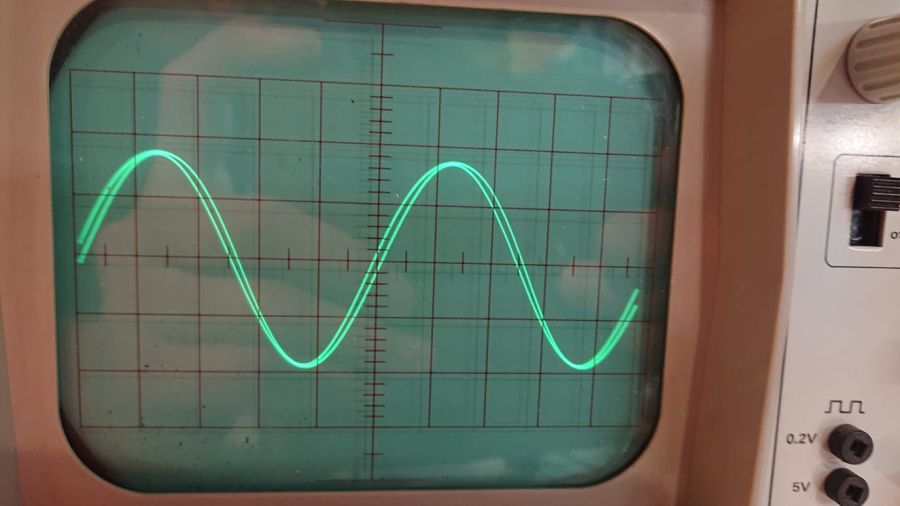
Overlay Input to Output, causing extremely high THD of almost 3%. Who's the culprit? I found R9/R10 to increase their resistance during heating up - unfortunately not equally, with values from 46 to 53 kOhms, going back to normal values after a few seconds.
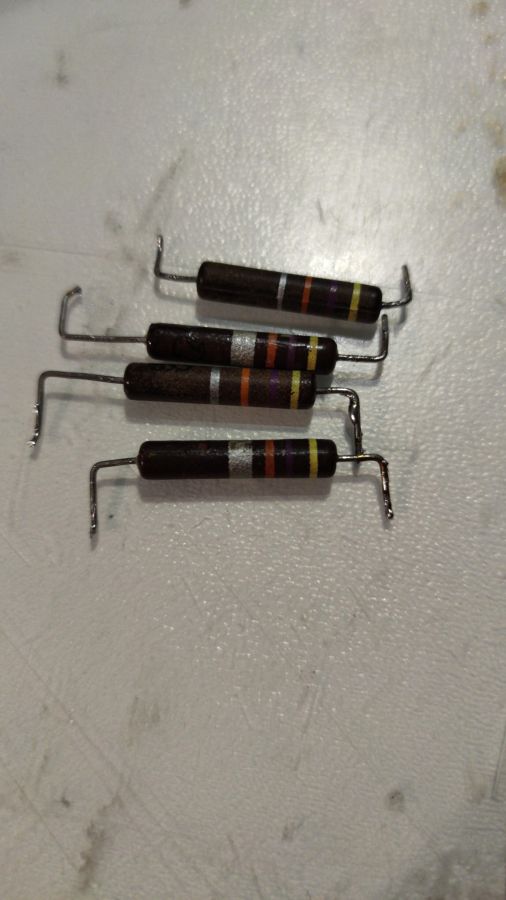
I took the BH apart and exchanged the carbon-composit with modern 3W types and adjusted everything afterwards. First session made me smile .
.
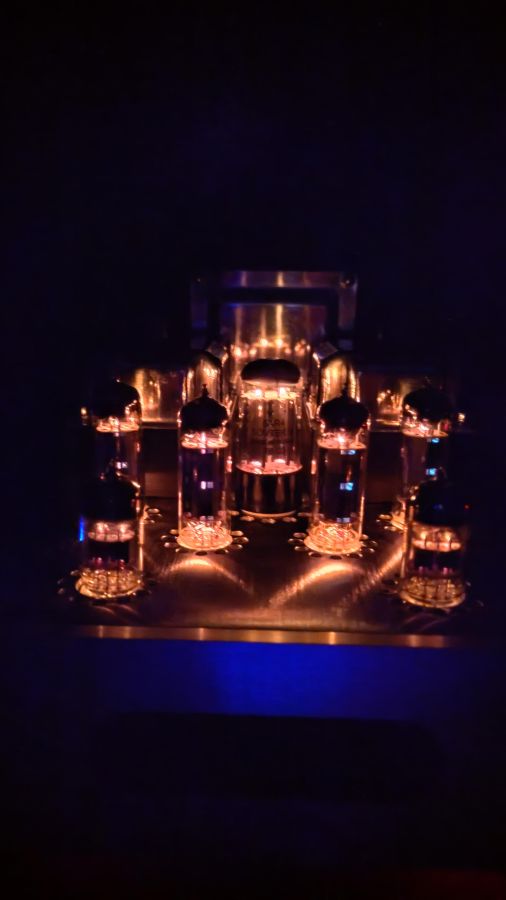
Lesson learned: Never, never ever again, to buy a or build a case just after positioning parts on the table, but to build it twice as big .
.
Have a good time!
Hi all,
good, to see you still writing!
It was (and is) a challenging year from any point o view, but last weekend I put my BH (some details here) on the bench again.
Problem: The sound of my BH got crappy relatively fast. Good in the beginning, but after a few Minutes it sounded like ... "rubbish" would be the best explanation. On the bench everything looked fine?! No way to enjoy music.
Yesterday I digged into it and found something strange. Even after hours all parameters looked like they should. Bias stayed rocksolid, so did the plates. I connected the scope to the BH, added my signal generator to the pre, listened to a few songs via CD and then switched to a 1 kHz Sinus. And here it was:
Overlay Input to Output, causing extremely high THD of almost 3%. Who's the culprit? I found R9/R10 to increase their resistance during heating up - unfortunately not equally, with values from 46 to 53 kOhms, going back to normal values after a few seconds.
I took the BH apart and exchanged the carbon-composit with modern 3W types and adjusted everything afterwards. First session made me smile
Lesson learned: Never, never ever again, to buy a or build a case just after positioning parts on the table, but to build it twice as big
Have a good time!
Attachments
Shoemaker said:I found R9/R10 to increase their resistance during heating up - unfortunately not equally, with values from 46 to 53 kOhms, going back to normal values after a few seconds.
Interesting experience! Thanks for sharing it.
I’m not seeing the reason for the deterioration in performance, if R9/R10 (carbon comp) went back to the specified value of 47k after warmup. Was the distortion noticed for a few seconds only, during warmup, as a result of uneven values of these anode feedback resistors? What “modern” 47k resistors are you using now?
Those glowing tubes on your reflective chassis are sure pretty!
Last edited:
Lesson learned: Never, never ever again, to buy a or build a case just after positioning parts on the table, but to build it twice as big .
Carbon comp resistors drift in value. A lot.
I just took a couple of 15k ohm 1W carbon comp resistors out of the drawer. One had never been used, the other was a 'pull'. Both are of the same batch, same origin, just that I had previously used one and not the other.
The unused resistor measured 14.87k ohms.
The previously used resistor measured 17.53k ohms. <== It drifted a lot!
If you require temperature stability and reasonably close tolerance value, then avoid carbon composition resistors. R9 and R10 are not a place I'd put a carbon comp resistor.
--
BTW, nice photo, and that is a pretty build.
--
Hi,
I've never seen such a strange behavior before. Testing on the bench - everything is fine. Listening to the music - crap. So, back to the bench ... This game was put on repeat for several times.
In fact I had 4 extremely temperature- and for that current-sensitive items in the amp. That worked for static biasing or with a constant sinusodial signal, but not for music. On the scope it looked like the output amplitude was dancing around the input amplitude for a few seconds, e.g. when increasing the input level.
Long story short: Bye-Bye - Bin! For now I've thrown 4 MOX (normal stuff, not from China) in I had in stock. I like CC more. Maybe just a bad batch?
Highly appreciate that you like the design and the pictures! Tubes in fact are beautiful models
I've never seen such a strange behavior before. Testing on the bench - everything is fine. Listening to the music - crap. So, back to the bench ... This game was put on repeat for several times.
In fact I had 4 extremely temperature- and for that current-sensitive items in the amp. That worked for static biasing or with a constant sinusodial signal, but not for music. On the scope it looked like the output amplitude was dancing around the input amplitude for a few seconds, e.g. when increasing the input level.
Long story short: Bye-Bye - Bin! For now I've thrown 4 MOX (normal stuff, not from China) in I had in stock. I like CC more. Maybe just a bad batch?
Highly appreciate that you like the design and the pictures! Tubes in fact are beautiful models
Last edited:
- Home
- Amplifiers
- Tubes / Valves
- EL84 Amp - Baby Huey
